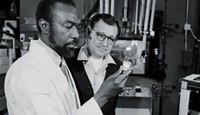Advertisement
Grab your lab coat. Let's get started
Welcome!
Welcome!
Create an account below to get 6 C&EN articles per month, receive newsletters and more - all free.
It seems this is your first time logging in online. Please enter the following information to continue.
As an ACS member you automatically get access to this site. All we need is few more details to create your reading experience.
Not you? Sign in with a different account.
Not you? Sign in with a different account.
ERROR 1
ERROR 1
ERROR 2
ERROR 2
ERROR 2
ERROR 2
ERROR 2
Password and Confirm password must match.
If you have an ACS member number, please enter it here so we can link this account to your membership. (optional)
ERROR 2
ACS values your privacy. By submitting your information, you are gaining access to C&EN and subscribing to our weekly newsletter. We use the information you provide to make your reading experience better, and we will never sell your data to third party members.
Periodic Table
Movers And Shakers
Kit Chapman tells stories of the superheavy elements
The science journalist’s new book explores the people and places at the edge of the periodic table
by Sam Lemonick
June 9, 2019
| A version of this story appeared in
Volume 97, Issue 23

The new book Superheavy: Making and Breaking the Periodic Table, about the discovery of elements beyond lawrencium, started with an argument. Author Kit Chapman, a freelance science writer and former Chemistry World editor, was listening to the radio and heard DJ Simon Mayo claim there were 118 known elements. It was December 2015 and element 116 was the heaviest confirmed so far. Chapman corrected Mayo on Twitter. But when scientists announced four new elements at the end of the year, Chapman thought, “What does a radio DJ know that I don’t?”
Vitals
▸ Profession: Freelance science journalist
▸ Hometown: Huntingdon, England
▸ Favorite superheavy element: Oganesson, element 118. “How many people get to say they’re friends with a person an element is named after?”
▸ Favorite International Year of the Periodic Table event: Seeing historical periodic tables going back 200 years at the University of Cambridge. “They also had the world’s most expensive periodic table, a stunning work of art made from a spiral of precious metals.”
▸ Superheavy US release date: Aug. 27, 2019
Chapman decided he needed to brush up on the superheavy elements—the ones after number 103, lawrencium. “And the more I looked into these elements, the more fascinated I became by the politicking that happened around element discovery and some of the crazy stunts they got up to,” he says. Those stories became the 21 chapters of Superheavy, set to be released in the US on Aug. 27.
In the book, Chapman starts a bit before the superheavy elements, charting the course of modern element discovery and synthesis, beginning with Enrico Fermi’s attempt to make the first transuranium elements in the 1930s. Uranium is the last element with long-lived isotopes on the periodic table. Neptunium and the elements that follow have so many protons that their nuclei spontaneously decay. By the time you reach the superheavies, the elements can be made only with massive, high-energy machines, and most disappear in fractions of a second.
The superheavy elements barely exist and have no known applications. So it seems fair to ask: Do they matter? “Oh, very much so,” Chapman says. He points out that theories suggest 172 elements can exist, which means that one-third of the table remains undiscovered. “For chemists, that’s incredibly exciting,” he says. If scientists can make those elements—and Chapman believes they one day will—their creation may overturn the rule that currently governs the periodic table: elements in the same column share similar properties. Scientists are already seeing hints that this rule is failing in the first chemical studies of known superheavies, with new elements behaving differently than their column mates. “I think we’re at the point now where periodicity is breaking,” Chapman says. “We need to start reappraising how we organize these elements.”
Like many books about science history, Superheavy is as much about the people as it is about the science. “I was expecting there to be interesting science stories,” Chapman says. “What I found is I was actually far more interested in the people.” The people featured in the book include luminaries like chemist Glenn T. Seaborg, who had a hand in discovering 10 transuranium elements, and physicist Yuri Oganessian, who is the only living person with an element named after them. But Chapman thinks it’s important that science writing includes people whose stories we don’t hear as often or as loudly—in particular, women and people of color. “I want to make science more accessible. I hope that looking back and seeing this cast and some of the diversity that’s reflected in the past, we can get more diversity in the future.”
Chapman says getting more diversity doesn’t mean sacrificing talent. He saw this principle in action at Oak Ridge National Laboratory (ORNL), one of the world’s foremost producers of transuranium isotopes. “No one talks about gender balances and ethnicities; people just focus on the science. Everyone’s there because they are incredibly able people,” he says.

But Chapman recently discovered that this respect for ability doesn’t necessarily exist outside laboratory walls. Clarice Phelps is a chemist at ORNL widely thought to be the first black woman to help discover an element, tennessine. On Twitter, Chapman gave her name to Jess Wade, a physicist at Imperial College London who has added hundreds of entries on women scientists to Wikipedia. Wade wrote a short entry about Phelps, but Wikipedia later deleted it after critics argued Phelps was not notable enough to warrant a page. Chapman thinks his tweet about Phelps drew trolls’ attention to the entry, which led to a campaign to delete the page. “That’s incredibly frustrating for me,” he says. One reason given for the entry’s deletion was that not enough independent sources describe Phelps’s contributions to discovering tennessine. Chapman sees that as a call to arms for science writers. “As a science journalist I think we have a duty to make sure that we are representing everyone in science. We choose who we talk to. And I think we need to reflect science as best we can with the widest diversity of voices.”
Chapman includes an impressive array of voices in Superheavy, making visits to element hunters in Germany, Japan, Russia, and the US. Riken in Japan, which made element 113, nihonium, stands out to him for its unique research culture. In the linear accelerator control room, where scientists observed three atoms of the element in 2012, Chapman spotted plush dolls of the local city mascots at the computer terminal.
He describes Russia’s Joint Institute for Nuclear Research (JINR) as looking like the scene of a Cold War spy thriller. That is an apt comparison because the race to find superheavy elements was often contentious and sometimes outright acrimonious between nations. During the Cold War, the element-hunting labs in Berkeley, California, and Dubna, Russia, were often at odds over who discovered which elements and who got to choose the names. But Chapman points out that scientific collaborations did occasionally cross otherwise impregnable political divides. In 1989, the directors of JINR and Lawrence Livermore National Laboratory agreed to work together to find the next superheavy elements. The Dubna-Livermore collaboration now claims the discovery of six elements, including the heaviest, oganesson, named after Oganessian, who leads the hunt for new elements at JINR. “Ultimately, collaboration seems to be the answer. When we look at when those breakthroughs were made, it’s when those collaborations happened,” Chapman says.
Making elements 119 and 120 are next. Chapman is in touch with the research teams looking for these elements, and he’s confident we’ll see them before long. What happens next is less clear. Chapman says scientists aren’t sure the existing approaches for making elements will work for those beyond 120. Facilities are getting older and might not be replaced, funding for this line of research is becoming harder to find, and young scientists are having trouble breaking into a small field with well-established senior researchers. Despite all those hurdles, Chapman is confident that scientists will continue to discover new elements. “Because the one thing you always see with these groups is these problems are always solved,” he says. For example, Chapman points out that in the 1970s scientists didn’t know how they would make the elements after seaborgium. Then Oganessian developed a new technique, and teams were off to the races again. Give it a decade, Chapman says, and someone will come up with a new technique that kicks off the next spurt of element discoveries.
CORRECTION
This story was updated on June 11, 2019, to correct the name of the radio host. He is Simon Mayo, and he is a radio DJ, not a composer. It was updated July 11, 2019, to correct the photo caption. The photo shows Chapman at the facility that discovered elements 107 through 112, not element 113.






Join the conversation
Contact the reporter
Submit a Letter to the Editor for publication
Engage with us on Twitter